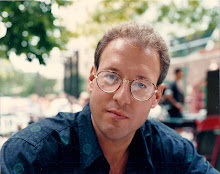 ANALYZE THIS! Neuromarketing is a bad pitch. Don't swing. (or as George Parker says, it was rubbish then and it's rubbish now)
ANALYZE THIS! Neuromarketing is a bad pitch. Don't swing. (or as George Parker says, it was rubbish then and it's rubbish now)You don't need neuromarketing to see if consumers lie. The truth is, when you talk to consumers, they can only tell you what they know. And they have been trained by expopsure to your ads and education - the lowest common denominator. In this environment I found after 45 years of consumer inquiry that if you ask consumers questions, you don't get the voice of the consumer, you get the voice of the inquirer through the question being asked - a form of bias that will lead you astray - and consumers wondering what to them seem to be dumb questions. Consumers are suspicious of advertisers, con men and thieves (you). But why bother with questions? As Atticus Finch said in To Kill A Mockingbird, "You can't ask a question you don't already know the answer to." And you only know so much.
So the only alternative is not to map or neuroanalyze brains or to ask consumers questions. The alternative is to stimulate consumer minds with in-depth, comprehensive, product-based written stimulative materials that cause them to think the thoughts they've not had about your products - sparking the creative process in earnest - and determining what really motivates people about your products. The materials prescribed cover product design, packaging, delivery systems, price, quality, image, attitudes, sensory, form, function, usage and over 500 other PRODUCT POTENTIALS or DIMENSIONS we've identified that all go into the perceptual mix.
In 45 years in packaged goods working with the cream of the crop I have found that if you ask consumers no questions they can tell you no lies - but you will know truth - and this is how George Mennen discovered that he should manufacture solid "Speed" stick antiperspirants - still the most popular today. This "question-free" process turned around brands such as Pampers, Folgers, Crisco, Pepto and many others for Procter & Gamble under the reign of 5 Chairman excluding Alan Lafely who is now letting the retailer tail wag the dog. It is also the root of the new product process that created Chunky Soup, Tic Tac Mints, Baked Lays Potato Chips, Cold-filtered Miller Genunine Draft Beer and 100 other code-cracking brands.
So whether it was Al Pacino or Robert DiNero who starred in ANALYZE THIS, analyze this.
You'll be wasting your time by helping neuroscientists make their next car payment. But the old marketers at the top, fearful of loosing their job, will tell new marketers to test anything they want - as long as it's not actually a better idea.
Clients exposed to Calle & Company processes (my company) stopped conducting focus groups years ago. And of course, we set the pace for the other early qualitative and quantitative pioneers. We concluded long ago that focus groups, need segmentation studies, in fact anything that put the consumer under a microscope put the consumer in an artificial environment - and no one performs well as a lab rat. So we stripped away the veneer of information gathering and measurement - in all of its ill-mannered forms - to avoid the pitfalls and poor traditions of question-based research. Our clients ended up hitting far more home runs, and their agencies put more award winning ads on Cannes reels.
Here is some advice I give to my family before we head to Del Mar, Santa Anita or Churchill Downs for the races. Give me the money. Go to the races. When you are done I'll give you your money back and you'll come out ahead. Don't swing. Neuromarketing is a bad pitch.











5 comments:
Ah focus groups. Getting pecked to death by ducks!
When Lindstrom (in Buyology) talks about the role of audio in advertising, he contextualises the findings in a way I haven't come across previously. How would your company be able to highlight the advantages of such a mechanism as auditory stimuli from your style of data-gathering.
This is not an attack, but a genuine query.
Good query. Not taken as an attack. Under the SENSORY PRODUCT DIMENSION or PRODUCT POTENTIAL (how does a product look, touch, taste, feel, smell, sound) we have looked at audio on every assignment for every product over the last 60 years. How is it used? Ever hear of "Snap, Crackle, Pop. Rice Krispies? Or the sound the door of an Oldsmobile makes when it closes? That campaign made Leo Burnett;s work famous for the brand. Copeland's music for beef was memorable, but didn't stop people from shying away from red meat. Some other Product Potential yet undiscovered is more relevant that could one day drive people back. Red meat just doesn't taste like red meat anymore. Not making any new age assertions here but soy fed, farm raised beef injected with hormones make red meat ain't what it used to be.
But why focus on one part (audio) out of only one product dimension (sensory) using your own mind or group of minds. There are hundreds of dimensions potentially (hence PRODUCT POTENTIALS) far more relevant than this drop in a bucket called audio. That's the kind of explorations our work fulfills with outstanding practical sales results (hence proven at companies like Procter & Gamble. In fact, using our methodologies rather than other's, our least successful new products have outperformed everyone else's most successful new products for the last 56 years.
I work as a sound designer for a major broadcaster and in my capacity I try and bring an 'informed' approach to this aspect of their output. As I only provide one aspect of the overall product I can only provide one part of the jigsaw. The problem for most creatives, is that they rely completely on the 'executioners' (i.e. editors, directors, graphic designers, sound designers etc) and so have little direct control over the actual work itself. Marketers need to realise this fact more acutely, that 'to conceptualise' is far removed from 'to realise'. By increasing the awareness of the roles individual players can perform to affect the overall impact of an assignment, then it can only be better for the advertiser and consumer. Audio has a big part to play, the problem is is that very few people understand how to utilise it. I have just finished campaigns for Ford & Coca Cola, and even within these world leaders, the audio is completely overlooked. Pity.
Post a Comment